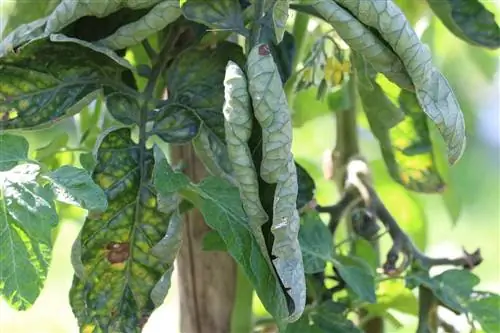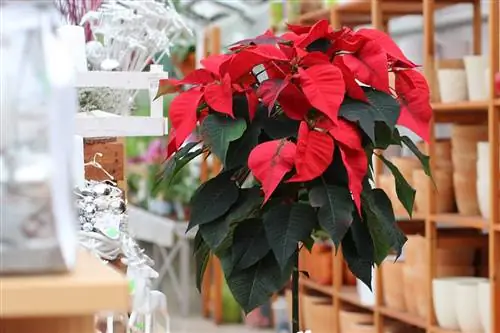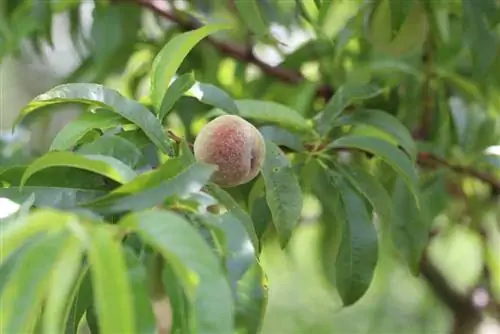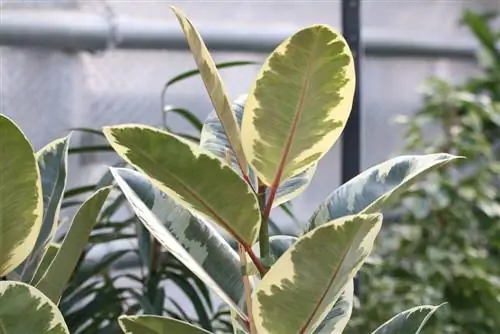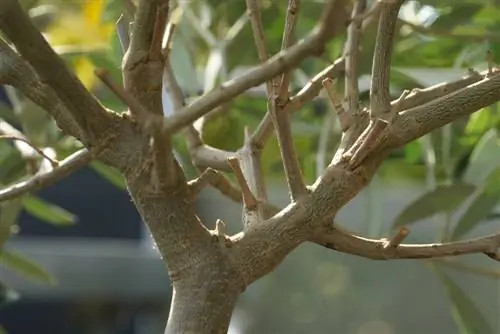- Author admin [email protected].
- Public 2023-12-17 03:39.
- Last modified 2025-01-24 12:45.
There can be a variety of causes for curled leaves on tomato plants. Some are harmless, others can ruin crops. Waiting is therefore not an option. Like a detective, you have to look for clues. And then, if feasible, take tailor-made countermeasures. What to do when tomato leaves curl.
Avoid drought
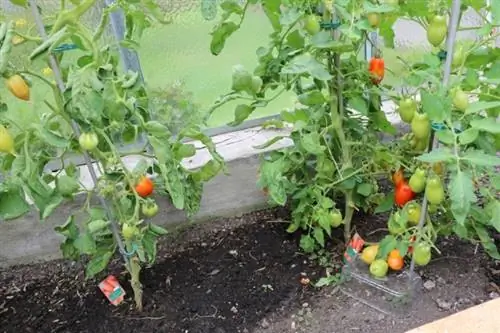
Tomatoes are thirsty plants. The sunnier they are and the warmer the weather, the higher their water requirements. If their thirst is not adequately quenched, whether by rain or watering, the leaves curl up. If the dryness lasts longer, they can yellow and dry out. You shouldn't let it get to that point, because these leaves can no longer be saved. How to react correctly:
- water affected tomato plants thoroughly immediately
- Place potted tomatoes in water container until root ball is soaked
- from now on, water regularly and as needed
- Provide water daily on hot days
Stop overfertilization
Yes, of course, as heavy eaters, tomatoes need a lot of nutrients. However, you must be careful not to give them too much nitrogen. The element stimulates leaf growth and causes a large number of (rolled) tomato leaves to be formed. Take these immediate actions:
- Temporarily stop fertilizing
- Water the tomato plant thoroughly over several days

Tip:
Use organic fertilizers such as compost (about 3 liters per square meter) or horn shavings to supply your tomato plants with nutrients. Both decompose slowly and only gradually release nitrogen. This is how you can reduce the risk of over-fertilization.
Reservedly exploited
For some tomato varieties, regular thinning is part of the care program. This also significantly reduces the leaf mass. This can cause tomato leaves to curl if the plant has more nutrients than it can absorb. Pause thinning until more leaves have formed. Water the affected plants thoroughly for a few days to flush out excess nutrients.
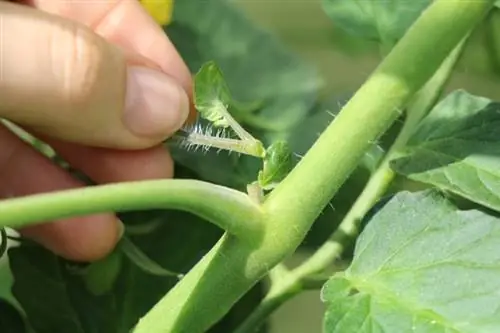
Add trace elements
Your tomato plants may be missing important trace elements. You can find out for sure what these are with a soil sample. But the leaves can also provide clues:
- Copper deficiency: small leaves with dark spots, leaf tips curled
- Zinc deficiency: upper leaves become smaller and curl; shortened sprout spacing
- Calcium deficiency: young leaves grow poorly and are deformed
- Boron deficiency: young leaves curl up
Compensate for the missing trace element with suitable fertilizer. For example, with copper sulfate, zinc s alt, boric acid or calcium-containing agents. Start practicing good floor care now to prevent this problem from recurring.
Note:
Tomatoes also need the trace element manganese. However, if there is an excess of this, the edges of the leaves become stained and tomato leaves curl and dry out.
Fighting diseases and pests
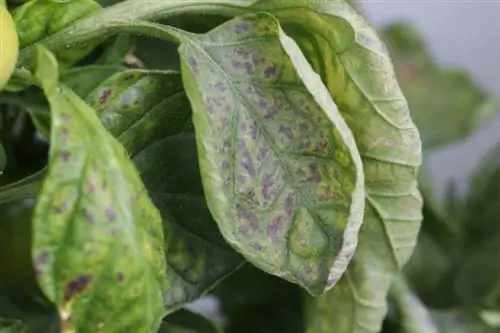
Diseases and pests can also cause tomato leaves to curl. But this usually happens long after a disease has broken out or pests have attacked the tomato plant. Unmistakable leaf spots or leaf discoloration appear first. Many pests are visible to the naked eye. The most common diseases and pests on tomato plants are:
- Diseases: leaf spot, blight, tomato mosaic virus
- Pests: aphids, spider mites, tomato rust mite
Check your tomato plants thoroughly to find out the specific cause. Then take recommended control measures. Natural sprays are often available for this purpose, such as nettle decoction against lice.
Tip:
If a tomato plant is already severely damaged by disease or pests, it is better to remove it from the bed and dispose of it as residual waste. This will prevent he althy plants from being attacked.
Temperature fluctuation as a cause
If there is a big difference in temperature between day and night, the tomato leaves also curl. There's nothing you can do about it outdoors. If your tomatoes are in the greenhouse, try to adjust the temperatures slightly.
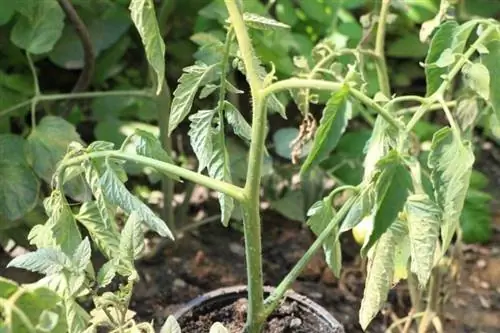
Note:
If young tomato plants still have curved leaves, the cause is usually harmless. Because they often sprout a lot of leaves while the root system is still “lagging behind” in its development. Wait, after two to four weeks the balance will be restored and the leaves will be as they should be.
Frequently asked questions
Which leaves on tomato plants should you remove?
Tomato leaves are important for the plant to carry out photosynthesis. In order to prevent diseases and promote drying after rain, it can be useful to remove the lowest leaves.
Do I need to remove curled tomato leaves?
If there is a disease or there are pests on the plant, you should remove curled leaves promptly and dispose of them as residual waste. Otherwise, you can leave the leaves on the plant. They can usually recover as soon as the cause is eliminated.
What do yellow leaves on tomato plants mean?
Yellow leaves usually indicate a deficiency. This can be a lack of light, lack of water or lack of nutrients. Even diseases and pests that are not controlled can ultimately result in yellow leaves.

